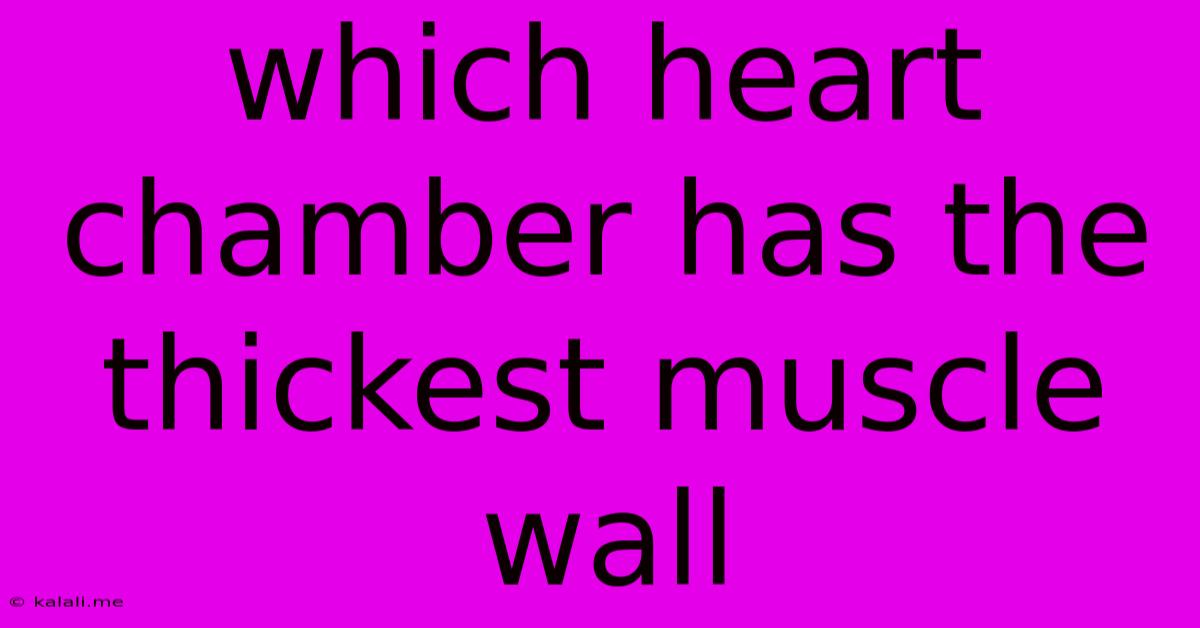Which Heart Chamber Has The Thickest Muscle Wall
Kalali
Jun 16, 2025 · 3 min read

Table of Contents
Which Heart Chamber Has the Thickest Muscle Wall? The Powerhouse of the Cardiovascular System
The human heart, a tireless engine, works relentlessly to pump blood throughout our bodies. But not all parts of this vital organ are created equal. Understanding the structure and function of the heart's chambers helps us appreciate its incredible capabilities. This article will delve into the specifics, answering the key question: which heart chamber boasts the thickest muscle wall? We'll explore the reasons behind this crucial anatomical feature and its importance for overall cardiovascular health.
The answer, simply put, is the left ventricle. This powerful chamber is responsible for pumping oxygenated blood to the entire body, a task requiring immense force. Therefore, its significantly thicker muscular wall is a testament to its demanding workload.
The Anatomy of a Powerful Pump: Why the Left Ventricle Needs Thick Walls
Compared to the other three chambers – the right atrium, right ventricle, and left atrium – the left ventricle has a substantially thicker myocardium (heart muscle). This difference isn't arbitrary; it's directly linked to the physiological demands placed upon it.
-
Higher Pressure: The left ventricle must pump blood into the aorta, the body's largest artery, which requires significantly higher pressure than pumping blood to the lungs (the function of the right ventricle). This higher pressure necessitates a thicker muscle wall to generate the necessary force.
-
Systemic Circulation: The left ventricle is responsible for systemic circulation, delivering oxygenated blood to all organs and tissues in the body. This vast network demands a powerful pump capable of overcoming significant resistance. The right ventricle, in contrast, only needs to pump blood to the lungs, a much shorter distance with less resistance.
-
Muscle Fiber Arrangement: The arrangement of muscle fibers within the left ventricle's wall contributes to its strength. These fibers are arranged in a complex spiral pattern, allowing for efficient contraction and forceful expulsion of blood.
Comparing the Heart Chambers: A Thickness Comparison
While the left ventricle's thickness is the most prominent, understanding the relative differences between all four chambers provides a complete picture:
- Left Ventricle: Thickest wall; responsible for pumping oxygenated blood to the body.
- Right Ventricle: Thinner wall than the left ventricle; responsible for pumping deoxygenated blood to the lungs.
- Left Atrium: Thin walls; receives oxygenated blood from the lungs.
- Right Atrium: Thin walls; receives deoxygenated blood from the body.
Implications for Cardiovascular Health
The thickness of the left ventricle's wall is crucial for overall cardiovascular health. Conditions like hypertension (high blood pressure) can lead to an increase in left ventricular wall thickness (left ventricular hypertrophy), potentially straining the heart and increasing the risk of heart failure. Conversely, a thin left ventricular wall might indicate underlying heart conditions. Regular check-ups and monitoring of heart health are vital to detect and address any abnormalities.
Understanding the anatomical differences between the heart's chambers, particularly the significantly thicker wall of the left ventricle, is key to grasping the complexities of the cardiovascular system and the importance of maintaining heart health. This knowledge emphasizes the importance of preventative measures, such as a healthy diet, regular exercise, and avoiding risky behaviors, to ensure the continued efficient operation of this incredible organ.
Latest Posts
Latest Posts
-
How To Create Clickable Image In Html
Jun 16, 2025
-
What Are The Factors Of 121
Jun 16, 2025
-
What Is A Theme Of The Passage
Jun 16, 2025
-
A Company That Provides Access To The Internet
Jun 16, 2025
-
Which Word Is Closest In Meaning To The Underlined Word
Jun 16, 2025
Related Post
Thank you for visiting our website which covers about Which Heart Chamber Has The Thickest Muscle Wall . We hope the information provided has been useful to you. Feel free to contact us if you have any questions or need further assistance. See you next time and don't miss to bookmark.